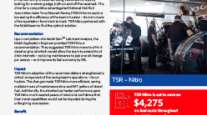Diesel Jumps 6.3¢ to $2.991
This story appears in the Aug. 16 print edition of Transport Topics.
The average price of a gallon of retail diesel in the country jumped 6.3 cents last week to $2.991, the largest one-week increase since early April, the Department of Energy reported.
Gasoline’s average price also spiked, by 4.8 cents, to $2.783 a gallon, DOE’s Energy Information Administration said after its Aug. 9 survey of fueling stations.
Diesel has risen three straight weeks by a total of 9.2 cents. It is at its highest level since May 24, the last time it topped $3 a gallon.
The increases left diesel 36.6 cents higher than it was a year earlier while gasoline was 13.6 cents above the corresponding week last year, DOE said. These increases translate into $47.4 million in added diesel expenses for U.S. truckers, and $13.7 million more for gasoline purchases, compared with only a week earlier. That is based on American Trucking Associations’ estimates that U.S. fleets burn 752 million gallons of diesel and 285 million gallons of gasoline each week.
An EIA analyst tied the rising fuel prices to crude oil increases.
“The price of crude oil has climbed more than $10 a barrel since early July,” said Neil Gamson, an EIA economist. “The price of
diesel hasn’t risen as high since early July in proportion to the increases in crude prices, as it often does. That’s probably attributed to two factors: First, the economy is growing very slowly, and diesel demand is increasing at the same very moderate pace.”
Crude rose from $71.98 a barrel July 6 to the high in its current upswing of $82.55 on Aug. 3 on the New York Mercantile Exchange. Oil closed at $78.02 on Aug. 11.
Trucking executives said the steep one-week increase has a large effect on their businesses.
“An increase like this week’s hits at the bottom line in an enormous way, and it’s hard, if not impossible, to ever recover it,” Patrick Quinn, president and co-chairman of U.S. Xpress Enterprises, Chattanooga, Tenn., told Transport Topics.
“We buy something in the range of 3 million gallons of fuel weekly for all of the fleets we have, and though we have fuel surcharges, when you take into account deadheading and making empty runs to pick up freight and other driving without freight, we only recover about 80% of any surcharge increase.”
Quinn added that another drawback was that when DOE an-nounces a large one-week increase on a Monday, diesel usually has been creeping up during the previous seven days.
“We also have to absorb that steady daily increase by ourselves until the following Monday when DOE puts out its new prices and we can change the surcharge,” Quinn said.
Jim Morgan, vice president of maintenance, Morgan Southern Inc., Conley, Ga., also said his company was stung by the steep increases.
“Prices that move upward quickly hurt us, especially if a lot of a week’s gain comes in a single day,” said Morgan.
“Let’s say it goes up big time one day in the middle of the week when we have a lot of freight moving,” he explained. “We can’t adjust the fuel charge, and the revenue that comes in
is based on the previous week’s surcharge, and that revenue is lost forever.”
Morgan said that his company still had many customers who resisted paying full surcharges, so that asking them for a mid-week in-crease was impossible.
Morgan Southern runs 240 tractors, 80 by owner-operators.
Shawn Moore, CEO of R.C. Moore Inc., Scarborough, Maine, also said the surcharge leaves his company short, but a long-range program is just starting to pay fuel-saving benefits.
“We have 100% of our customers on fuel surcharges, but there’s no way we can recover it all, because you have a certain amount of deadhead miles, and then stiff increases like this week will lose you more,” Moore told TT.
Moore said that the company, which operates 120 tractors and 320 trailers, signed up 18 months previously for a fuel optimization plan that would direct drivers to the cheapest fuel locations on their routes.
“We had internal problems getting this program straight, and it’s only in recent weeks that we’re finally seeing results,” Moore said. “If we get as much as we hope, it’ll cut our fuel expenses by 12%.”




